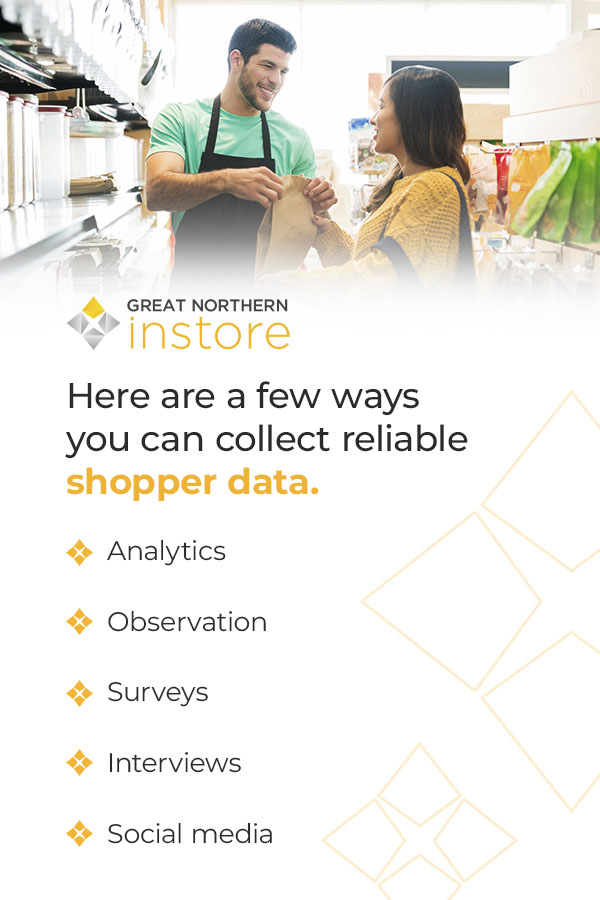
Shopper marketing strategies are highly effective tactics that differentiate products on store shelves and increase sales and loyalty. These tactics succeed due to shopper insights — a comprehensive understanding of the motivation behind a customer’s actions.
Learn more about shopper insights, what they can do for your business and how to find and apply them in this guide. You’ll also get valuable information about common challenges that hinder the research process and some examples of shopper insights from Great Northern Instore.
What Are Shopper Insights?
A poorly informed shopper marketing strategy will eventually crumble like a building without a foundation. An insight is a penetrating understanding or powerful knowledge about the subject matter. If we apply this to marketing, shopper insights are an informed intuition of how and why consumers buy products.
From awareness to purchase and beyond, businesses can use research tools to uncover milestones along the shopper’s journey. They can then use this information to craft marketing strategies. Using data to back decisions is a tried-and-true way to meet consumer needs head-on.
What Is Shopper Insight Data?
Shopper insights revolve around customers’ thoughts, beliefs, values, behaviors, motivation and demographics. They can include information like this:
- Demographics like age, gender and race.
- What they buy, why they choose specific products over others and how often they purchase.
- When and where they shop and how long they take.
- How they make their purchases and how much they spend.
- What gets purchased together on shopper trips.
- Their opinion about brands, products and shopping experiences.
Once you collect this data, you can analyze it to find actionable information to help your business thrive.
Benefits of Using Shopper Insights in Retail
Shopper insights are vital to anyone selling products at retail, including manufacturers and marketing agencies. Your business will realize the following advantages when you invest time and money in shopper insights. Combine this with retail insights, which focuses on retail trends and purchasing patterns over time, and a brand has powerful tools to craft a strategy.
Understand Your Target Audience
All marketing efforts aim to understand the business’ ideal customer so they can attract and convince them to purchase their products and services. By researching shoppers, you will learn how to influence their decisions and improve their experience. You will also discover changes in their behavior and adapt your offerings to stay relevant.
Uncover Top Products
Monitoring purchasing behavior will give you a definitive idea of which products perform best. You can also identify what is frequently out of stock or slow-moving, allowing you to meet demand and reduce waste. Shoppers may say they want one thing, but their actions sometimes prove otherwise.
Gain a Competitive Advantage
Your customers will eventually look elsewhere if your products do not meet their needs. Shopper insights give you a one-up on your competition by uncovering why shoppers make their purchases and what influences them to choose one brand over another. You’ll be aware of trends as they happen, allowing you to capitalize on them before others. With this information, your business can tailor your retail merchandising and marketing strategies to encourage shoppers to choose your brand.
Improve Campaign Performance
Generic marketing messages no longer impress people. You need to tailor your marketing to get buyers to notice your brand and hear what you have to say. Start by segmenting your audience, creating messaging that reflects their unique needs and offering recommendations and ads based on their preferences. Personalized marketing is more relevant and impactful — 80% of customers prefer brands that offer experiences made for them.
Shopper marketing will aid in personalization efforts and ultimately increase your campaigns’ effectiveness. You will build satisfaction and loyalty and gain new customers. Additionally, shopper insights can uncover which marketing channels they prefer so you can optimize your marketing mix and save time and money.
What Is the Difference Between Consumer and Shopper Data?
Most of the time, the person making the purchase is the consumer, but there are instances when that isn’t the case. For example, a mother buying her child clothing is the shopper, and the child is the consumer. Similarly for the pet category, the shopper buys the product and their pet is the consumer.
Consumer data and insights are essential for businesses to understand their target audience’s wants and needs. Brands can glean helpful shopper insights from consumer data, but the two are ultimately separate. Retailers and brands selling to retailers must focus on the shopping experience, whether online or in a brick-and-mortar shop.
Common Data-Driven Marketing Challenges
While shopper insights provide multiple benefits for retail businesses, finding and implementing them can be challenging. Below are three primary challenges businesses face with shopper research and how to overcome them.
1. Data Collection
You need a trove of data to gain valuable insights into shoppers. Consistent access to timely information about consumers can help you identify trends and understand evolving characteristics. Shopper behavior can change frequently, so you should update your data as often as possible. However, many store owners and retail marketers struggle to find this data, which limits their ability to understand and enhance the customer experience.
Here are a few ways you can collect reliable shopper data.
- Analytics: Information such as clicks, visit duration and shopping cart use can help you understand how shoppers behave online. In physical stores, you can use point-of-sale and loyalty program data — such as what people bought and how often — to understand consumers better.
- Observation: Paying attention is another way to collect information. Watch your in-store customers to see how they behave. You can also install cameras and devices that track foot traffic throughout the store and eye movement while people browse.
- Surveys: In-store and online surveys are an effective way to gain feedback directly from shoppers. Keep questions clear and provide an incentive to encourage responses.
- Interviews: You can ask in-depth questions to get into customers’ minds. An interview is an effective way to do so, as you can ask them to share their thoughts and opinions. Interviewing people while they shop may yield even more valuable insights.
- Social media: Online communities offer a wealth of information for retailers. Browse social media sites for reviews and opinions from shoppers to understand where you can improve their experience.
2. Low-Quality Data
Gathering quality data for decision-making is one of the most challenging parts of marketing. However, this step is essential. Incomplete or false information can lead to misinformed decisions and failed communication efforts. To ensure high-quality data, you should:
- Standardize and organize data-gathering methods and check for issues during the collection process.
- Ask insightful questions to avoid confusion or ambiguity and ensure all data is valid.
- Audit and clean your data frequently, removing any poor-quality, incomplete or out-of-date information.
- Store the data in a safe, organized way to maintain its usefulness.
3. Analyzing and Understanding Data
Data interpretation is another challenge with the shopper insight process. Drawing insights from data can boost your marketing efforts. Here are a few tips to help you analyze your data and make informed decisions.
- Gather all your data in one consolidated place to make looking for patterns and similarities easier.
- Discard any useless or surface-level information.
- Arrange the data in segments, such as shopper age, behavior or preferences. These will help you identify insights for each category.
- Sort the data into a visual format, such as graphs and tables.
How to Use Shopper Insights in Your Marketing Strategy
Once you have gathered and analyzed reliable and accurate data about shoppers, it is time to use them to boost your marketing efforts.
1. Set Goals
Having goals for your shopper insight research project will outline the desired outcome from the beginning. Your research goals will inform which data to collect, where to look for it and what insights you need to achieve the goal. Without defined objectives, you may find your data does not provide the information you need to see results and a return on investment.
2. Apply the Data
Once you have gathered, organized and analyzed your data, it is time to incorporate it into your shopper marketing strategy. You can use your insights to tailor your advertisements and promotions, adjust your in-store displays, revamp your website and even alter products. Look to your goals and research findings for the best way to apply them.
3. Measure Performance
The final part of the process is to track how well your campaigns or adjustments perform after applying your research findings. The results will indicate how accurate and effective your insights and overall research process are. Analyze the results, look for improvement opportunities and apply them to future endeavors to optimize your strategy and improve effectiveness.
How to Turn Data Into Action
After thorough research, you should have some insights that can be an effective growth tool when used correctly. Remember, an insight is only as powerful as its implementation. If you work in the retail industry, here are a few ways you can use your findings to increase shopper satisfaction and drive sales.
1. Optimize Store Layout
A store layout significantly influences shopper purchases and their experience. Through observation and interviews, you may find layout problems like bottlenecks or slow zones. You may want to adjust the floor plan to increase sales in product categories. Test different product placement locations based on your findings to see what changes bring the best results.
2. Design Custom Retail Displays
One of your shopper marketing goals may be to increase product sales and brand awareness. You can achieve this by attracting attention with bright, visually appealing retail displays. You can customize these displays to hold the products differently than typical shelves and apply your visuals consistently to increase brand awareness. Retail displays are traditionally a successful marketing tactic, particularly for new item launches, seasonal promotions, and solution selling. Shopper insights can help with the design of the display.
3. Place Products Strategically
Product placement is a simple but effective way to influence shoppers and encourage purchasing. Lighting, order, height and design all draw attention and encourage impulse purchases. Analyze your findings to look for opportunities to improve product placement, including what are appropraite adjacent projects to drive larger basket sizes. You can change shelf positioning, create a separate display, partner them with complementary products or move them to another area.
Industry Insights From Great Northern Instore
It is much easier to understand shopper insights when you examine real-life examples. At Great Northern Instore, we help our customers win by doing what others can’t or won’t. Shopper insights are a major reason we can achieve this. Below are some insights we have uncovered over the years to give you an example of how shopper insights differ in each industry.
Back to School
Back to school is one of the most lucrative times of year for stationery retailers, with each shopper spending an average of $864 on school items and $1,199 on college items in 2022. Brand awareness is increasingly critical for driving growth in the school supplies market.
Budget-conscious families are increasingly concerned about inflation, shrinkflation and overpaying for school supplies. Perhaps unsurprisingly, 77% of buyers in this category choose alternative products if the prices are too high, and they typically look for coupons and sales before making a purchase. Back-to-school shoppers compare prices online and make online purchases more often, though in-store sales are picking up, too. Connecting to the emotions of both the parent and child are key for success.
Holidays
Retail merchandising during holidays — including Black Friday and Cyber Monday — successfully captures attention and drives sales. We have discovered fascinating insights and trends from audits of our client campaigns. Despite a dip due to COVID-19, holiday sales are rising and people are starting their shopping earlier than in previous years to ensure they get the gifts their loved ones want.
There is also a spike in online sales, with 55% of survey respondents saying they shop exclusively online. Most notably, there is a focus on shopping locally and supporting small businesses. We have also noticed that customers are returning to stores for the experience — they enjoy walking around and seeing what new things are on display, using the physcial store to inspire them and find the right gifts.
Pets
Our pet industry webinar has valuable trends and insights companies can use to inform their business and marketing strategies. This sector is growing, with consumers spending more on their pets in recent years. Interestingly, 86% of pet owners shop online, and subscriptions are popular.
Particularly with the younger generations, there is a trend of humanization. For example, owners focused on their pets’ health buy premium or organic pet food. Additionally, nearly 80% of pet owners purchase gifts for their pets, especially over the holidays. Eye-catching displays for treats, costumes and toys will surely capture their attention. Retail stores are driving physical traffic to drive impulse purchases by bolstering services such as grooming.
Sign up for Our Webinars to Learn More
With over 60 years in the retail display industry, Great Northern Instore has the retailer knowledge and experience to make any project a success. At the foundation of our strategy are research and shopper insights that our team of award-winning experts use to fuel creative ideation.
Sharing our wealth of shopper insights will help other businesses thrive, so we created our Win at Retail webinar series. During each webinar, we discuss actionable shopper insights for targeted retail industries. Some industries we cover include food and beverage, health and beauty, consumer electronics, pet care and office supplies.
Register for our next webinar today to learn about the latest insights you can use in your in-store promotions.










